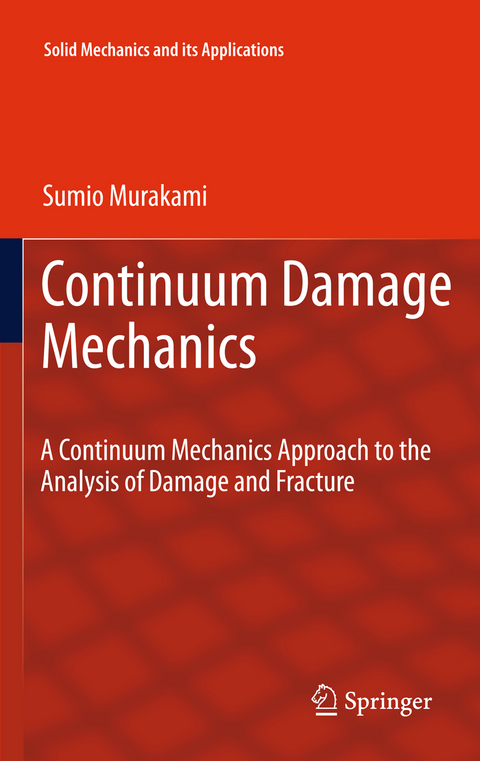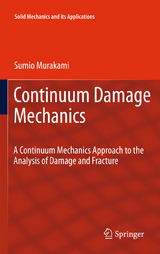Continuum Damage Mechanics
Recent developments in engineering and technology have brought about serious and enlarged demands for reliability, safety and economy in wide range of fields such as aeronautics, nuclear engineering, civil and structural engineering, automotive and production industry. This, in turn, has caused more interest in continuum damage mechanics and its engineering applications.
This book aims to give a concise overview of the current state of damage mechanics, and then to show the fascinating possibility of this promising branch of mechanics, and to provide researchers, engineers and graduate students with an intelligible and self-contained textbook.
The book consists of two parts and an appendix. Part I is concerned with the foundation of continuum damage mechanics. Basic concepts of material damage and the mechanical representation of damage state of various kinds are described in Chapters 1 and 2. In Chapters 3-5, irreversible thermodynamics, thermodynamic constitutive theory and its application to the modeling of the constitutive and the evolution equations of damaged materials are descried as a systematic basis for the subsequent development throughout the book.
Part II describes the application of the fundamental theories developed in Part I to typical damage and fracture problems encountered in various fields of the current engineering. Important engineering aspects of elastic-plastic or ductile damage, their damage mechanics modeling and their further refinement are first discussed in Chapter 6. Chapters 7 and 8 are concerned with the modeling of fatigue, creep, creep-fatigue and their engineering application. Damage mechanics modeling of complicated crack closure behavior in elastic-brittle and composite materials are discussed in Chapters 9 and 10. In Chapter 11, applicability of the local approach to fracture by means of damage mechanics and finite element method, and the ensuingmathematical and numerical problems are briefly discussed.
A proper understanding of the subject matter requires knowledge of tensor algebra and tensor calculus. At the end of this book, therefore, the foundations of tensor analysis are presented in the Appendix, especially for readers with insufficient mathematical background, but with keen interest in this exciting field of mechanics.
Preface.- List of Symbols.- PART I Foundations of Continuum Damage Mechanics.- 1. Material Damage and Continuum Damage Mechanics.- 1.1 Damage and its Microscopic Mechanisms.- 1.2 Representative Volume Element and Continuum Damage Mechanics.- 2. Mechanical Representation of Damage and Damage Variables.- 2.1 Mechanical Modeling of Damage.- 2.2 Mechanical Representation of Three-Dimensional Damage State.- 2.3 Effective Stress and Hypothesis of Mechanical Equivalence.- 2.4 Elastic Constitutive Equation and Elastic Modulus Tensor of Damaged Material.- 2.5 Procedure of Continuum Damage Mechanics and its Refinement.- 3. Thermodynamics of Damaged Material.- 3.1 Thermodynamics of Continuum.- 3.2 Thermodynamic Constitutive Theory of Inelasticity with Internal Variables.- 3.3 Extension of Thermodynamic Constitutive Theory of Inelasticity.- 4. Inelastic Constitutive Equations and Evolution Equations of Material with Isotropic Damage.- 4.1 One-Dimensional Inelastic Constitutive Equation of Material with Isotropic Damage.- 4.2 Three-Dimensional Inelastic Constitutive Equations of Material with Isotropic Damage.- 4.3 Strain Energy Release Rate and Stress Criterion for Damage Development in Elastic-Plastic Damage.- 4.4 Inelastic Damage Theory based on Hypothesis of Total Energy Equivalence.- 5. InelasticConstitutive Equation and Damage Evolution Equation of Material with Anisotropic Damage.- 5.1 Elastic-Plastic Anisotropic Damage Theory based on Second-Order Symmetric Damage Tensor.- 5.2 Elastic-Plastic Anisotropic Damage Theory in Stress Space.- 5.3 Fourth-Order Symmetric Damage Tensor and its Application to Elastic-Plastic-Brittle Damage.- PART II Application of Continuum Damage Mechanics.- 6. Elastic-Plastic Damage.- 6.1 Constitutive and Evolution Equations of Elastic-Plastic Damage - Ductile Damage, Brittle Damage and Quasi-Brittle Damage.- 6.2 Ductile Damage and Ductile Fracture.- 6.3 Application to Metal Forming Process.- 6.4 Analysis of Sheet Forming Limit by Anisotropic Damage Theory.- 6.5 Constitutive Equations of Void-Containing Ductile Material.- 6.6 Continuum Damage Mechanics Theory with Plastic Compressibility.- 7. Fatigue Damage.- 7.1 High Cycle Fatigue .- 7.2 Low Cycle Fatigue.- 7.3 Uncoupled Numerical Analysis of Very Low Cycle Fatigue.- 8. Creep Damage and Creep-Fatigue Damage.- 8.1 Creep Damage and Phenomenological Theory of Creep Damage.- 8.2 Viscoplastic Damage Theory of Creep Damage.- 8.3 Creep-Fatigue Damage.- 8.4 Effect of Damage Field on Stress Field at a Creep Crack Tip.- 9. Elastic-Brittle Damage.- 9.1 Damage ofElastic-Brittle Material.- 9.2 Isotropic Damage Theory of Concrete.- 9.3 Anisotropic Brittle Damage Theory by Second-Order Damage Tensor.- 9.4 Anisotropic Brittle Damage Theory with Elastic Modulus Tensor as Damage Variable.- 9.5 Anisotropic Brittle Damage Theory with Compliance Tensor as Damage Variable.- 10. Continuum Damage Mechanics of Composite Material.- 10.1 Damage of Laminate Composites.- 10.2 Elastic-Brittle Damage of Ceramic Matrix Composites.- 10.3 Local Theory of Metal Matrix Composites.- 11. Local Approach to Damage and Fracture Analysis.- 11.1 Local Approach to Fracture Based on Continuum Damage Mechanics and Finite Element Method.- 11.2 Mesh-Sensitivity in Time-Independent Deformation.- 11.3 Regularization of Strain and Damage Localization in Time-Independent Materials.- 11.4 Mesh-Sensitivity in Time-Dependent Deformation.- 11.5 Causes of Mesh-Sensitivity in Time-Dependent Deformation.- APPENDIX Foundations of Tensor Analysis.- A.1 Vectors and Tensors.- A.2 Vector Product, Tensor Product and the Components of Tensors.- A.3 Orthogonal Transformation, Invariants and Eigenvalues of Tensors.- A.4 Differentiation and Integral of Tensor Fields.- A.5 Differential Calculus of Tensor Functions.- A.6 Representation Theorem for Tensor Functions.- A.7 Matrix Representation of Tensors and Tensor Relations.- Reference Books and Bibliography.- Subject Index.
| Reihe/Serie | Solid Mechanics and Its Applications ; 185 |
|---|---|
| Zusatzinfo | XXX, 402 p. |
| Verlagsort | Dordrecht |
| Sprache | englisch |
| Maße | 155 x 235 mm |
| Themenwelt | Mathematik / Informatik ► Mathematik ► Wahrscheinlichkeit / Kombinatorik |
| Naturwissenschaften ► Physik / Astronomie ► Mechanik | |
| Technik ► Maschinenbau | |
| Schlagworte | Analysis • Continuum Mechanics • damage mechanics • Elasticity • fracture mechanics • thermodynamics |
| ISBN-10 | 94-007-2665-1 / 9400726651 |
| ISBN-13 | 978-94-007-2665-9 / 9789400726659 |
| Zustand | Neuware |
| Haben Sie eine Frage zum Produkt? |
aus dem Bereich




